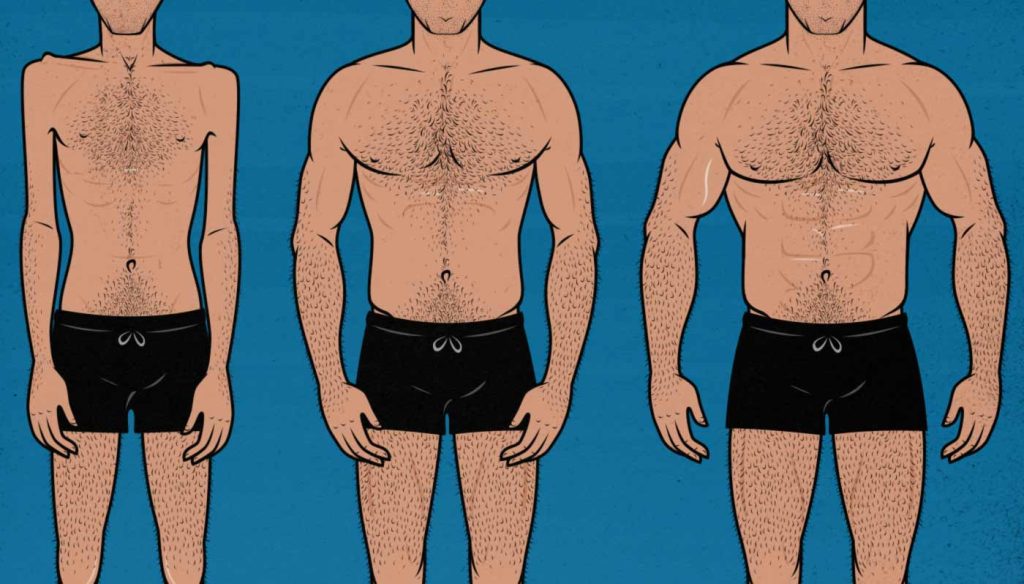
Are You a Beginner, Intermediate, or Advanced Lifter?
How can you tell whether you’re a beginner, intermediate, or advanced lifter? That’s a good question. The answer can change which exercises you build your routine around, which workout program you pick, how quickly you can add weight to the bar, and how quickly you should gain weight.
Let’s delve into different ways of determining your lifting level. We’ll demonstrate why some of those methods are flawed, then cover a more useful way of doing it.
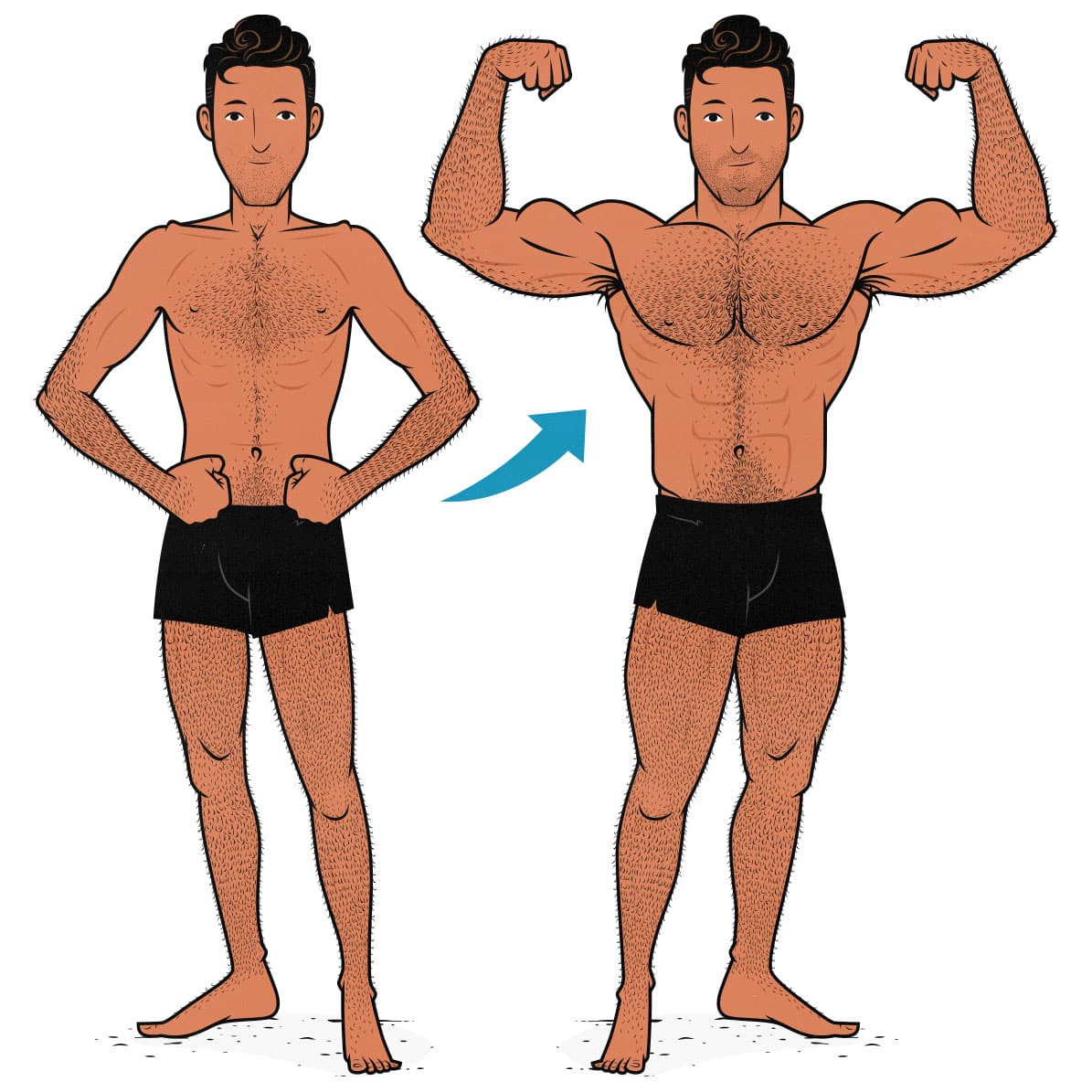
The Standard Ways of Determining Lifting Level
There are a few conventional ways of determining someone’s lifting level. Unfortunately, most of them are flawed. There’s a certain logic to them, but they fall apart as soon as we start poking holes in them. Let’s go over their pros and cons.
How Long Have You Been lifting?
The first lousy method relies on how long you’ve been lifting weights. The classification goes something like this:
- Beginner lifter: someone who’s been lifting for less than six months.
- Intermediate lifter: someone who’s been lifting for six months up to around two years.
- Advanced lifter: someone who’s been lifting for more than two years.
Now, these numbers can change. Sometimes the advanced label is reserved for guys who have been lifting for over a decade. That’s okay. No matter what the numbers are, this remains an ineffective way to classify someone’s lifting level.
Let’s consider a few examples.
- Someone’s been lifting weights poorly for ten years. They still can’t squat or deadlift with admirable technique. Are they an advanced lifter?
- Someone’s been bodybuilding for two years without gaining muscle. Because they haven’t been eating enough to gain weight, they haven’t gained a noticeable amount of muscle yet. Are they an intermediate bodybuilder?
- Someone who’s been strength training for five years without gaining much strength. Imagine someone who’s been trying to gain strength for several years without any success. Does failing for longer make you more advanced?
How Strong Are You?
You’ll often hear is that you’re a beginner until you can overhead press 135, bench 225 pounds, squat 315, and deadlift 405. The strength standards vary, but the classification system might look something like this:
- Beginner lifter: someone who can’t lift much weight yet.
- Intermediate lifter: someone who can barbell curl 100 pounds, overhead press 135, bench press 225, squat 315, and deadlift 405.
- Advanced lifter: someone who can barbell curl 135 pounds, overhead press 185, bench press 315, squat 405, and deadlift 495.
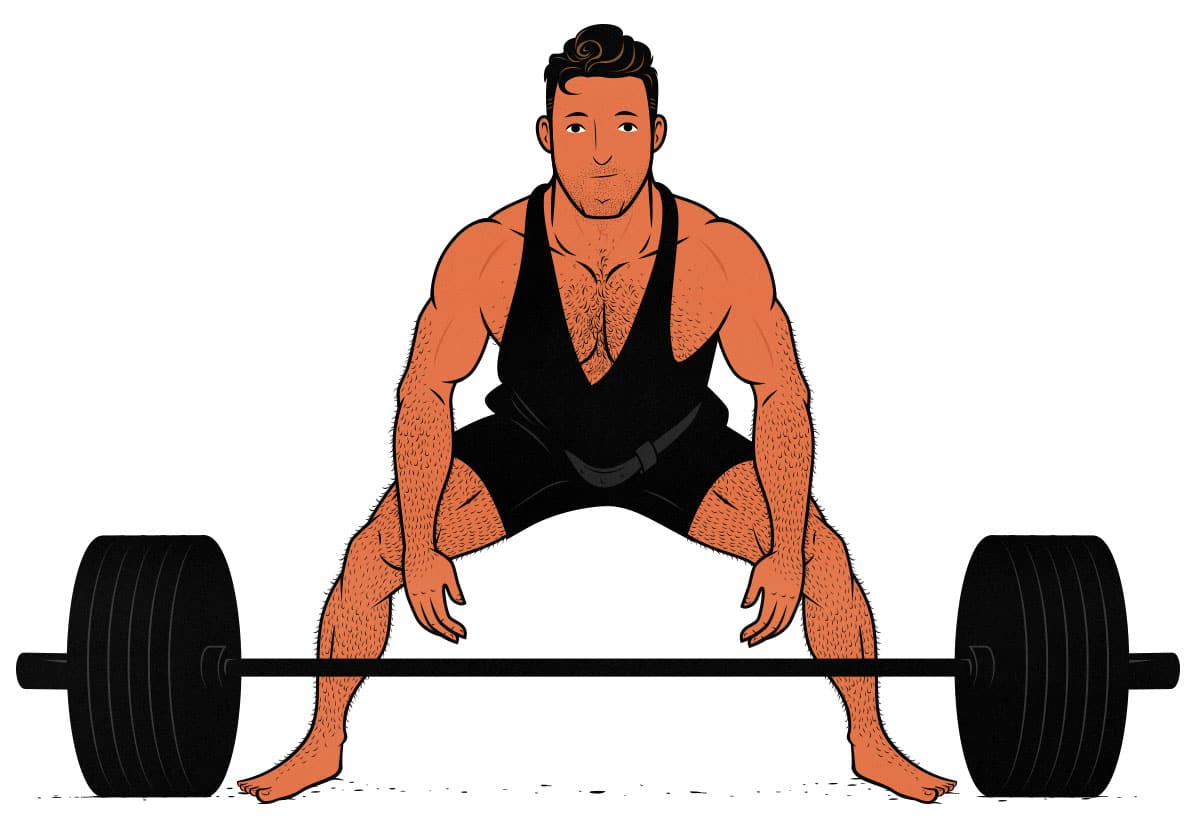
This method has some problems, but it’s also rather fun, and I enjoy it quite a lot. After all, it’s a blast to have strength benchmarks to aim for. It makes lifting more like a video game, where every level is clearly defined, and progressing simply means achieving a list of arbitrary requirements. I dig that.
It isn’t actually all that useful at determining someone’s lifting level, though, no matter how much we may (or may not) enjoy it. Consider a few examples:
- You’re trying to build muscle, not become a powerlifter. Unless you’re a powerlifter, you don’t need to centre your training around improving your low-bar barbell back squat, your wide-grip bench press, and your deadlift. Strength training isn’t ideal for building muscle, so why would you base your experience level on it?
- You’re naturally weak or strong. Genetics and lifestyle play an enormous role in determining someone’s strength when they first begin lifting. Some guys start off benching 315 pounds; other guys, such as myself, start off benching the barbell. Does that mean that some guys start as advanced lifters, whereas others will be beginners for years?
- Weight classes confound things further. These strength standards are typically organized into weight classes. However, as you gain muscle, you’ll advance through the weight classes. That means that your experience level will fall backwards whenever you gain enough muscle to move into the next weight class.
- Overweight people have much stronger lower bodies. The more overweight you are, the more weight you’ll need to carry around, so the more muscle you’ll build in the muscles that have to do that carrying. This means that overweight people can often squat quite a bit more weight than skinny guys.
- Genetics influence strength on several levels. Our anthropometrics influence how much we can. Having a thicker ribcage will help you bench more weight. Having longer arms will help you deadlift more weight. Having shorter legs will help you squat more weight. Our muscle insertions can play a big role here, too.
- You have different goals. Let’s imagine that you want big biceps. The bench press, squat, and deadlift won’t help with that. So you choose biceps curls instead. Now it’s your barbell curl strength that matters. You’re playing by different rules.
How Muscular Are You?
We’re a bulking site for skinny guys, so this one hits closest to home. It’s common for people to judge someone’s experience level by how big and muscular they are. The system might look something like this:
- Beginner bodybuilder: someone who’s still reasonably small. Maybe they’ve got 12-inch biceps.
- Intermediate bodybuilder: someone who looks like they lift. Maybe they’ve got 14-inch biceps.
- Advanced bodybuilder: someone who looks like a bodybuilder. Maybe they’ve got 16-inch biceps.
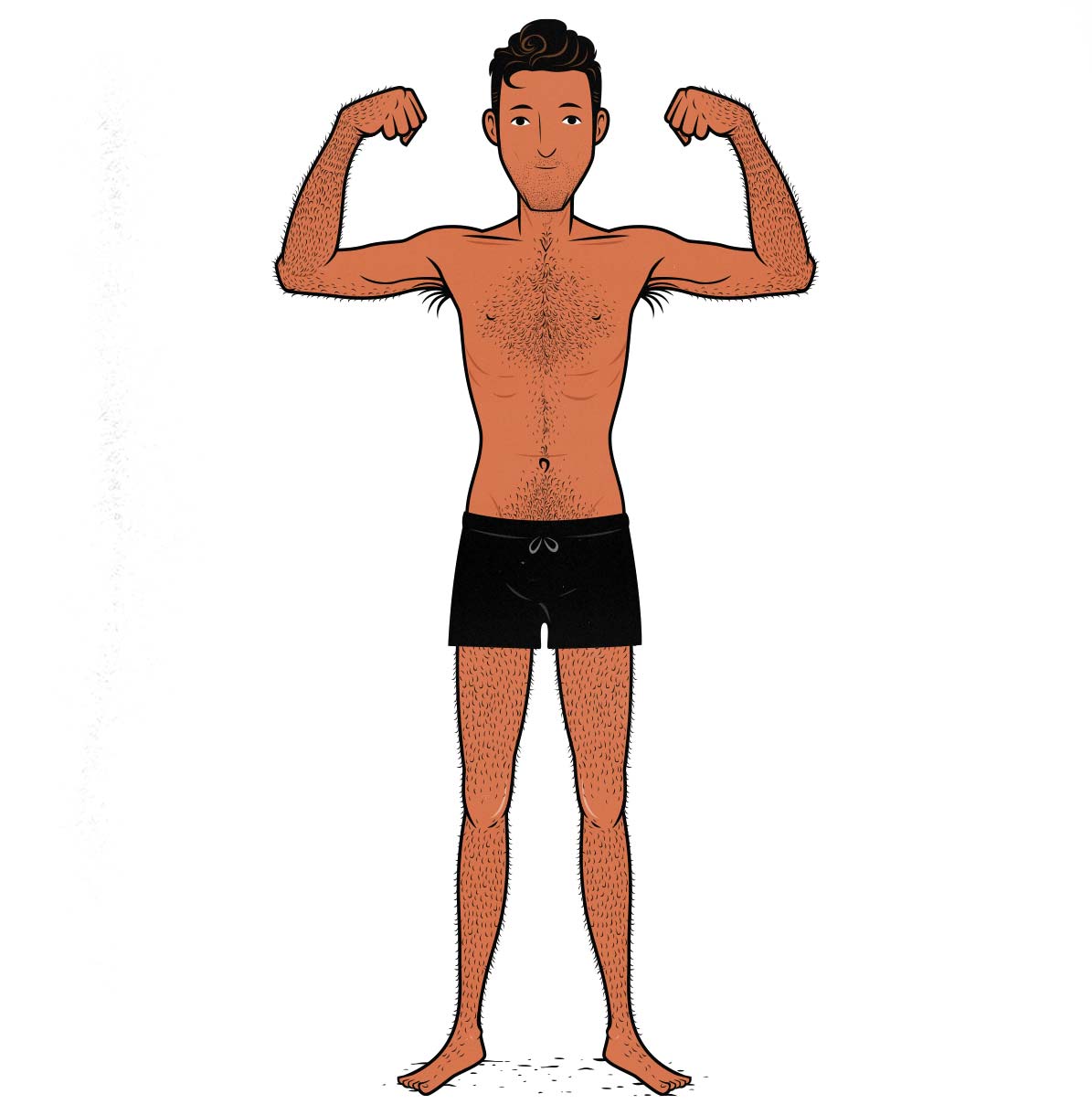
This system doesn’t usually go much deeper than glancing at someone to gauge their muscularity. If someone is small, do they even lift? They must be a beginner. If they’re jacked, they must be an advanced bodybuilder. This fails for a few reasons:
- Different people start with different degrees of muscularity.
- Different people can reach different degrees of muscularity.
- It doesn’t take into account skill or experience.
- It doesn’t tell you which workout program you should follow.
Why Your Lifting Level Matters
The first thing we need to do is figure out why we even care about a lifter’s experience level in the first place. As far as I can figure it, we care about our lifting level for three reasons:
- We’re trying to figure out which lifts are appropriate for us. Should we be doing simpler lifts that are easy to learn, or should we be doing more technical lifts that allow for heavier loading?
- We’re trying to figure out how quickly we should gain weight while bulking. Should we be capitalizing on newbie gains and gaining weight quickly, or will we benefit from a slower bulk because we’re nearing our muscular genetic potential?
- We’re trying to figure out how quickly we should add weight to the bar. Should we be doing a program that has us doing the same lift several times per week to rapidly increase our strength? Or should we be attempting to gain strength less often than that?
If we can answer these questions, then we can find the level of workout program that suits us best. Let’s go through them one by one.
How Good at the Lifts are You?
Our goal here is to figure out which lifts you’ll get the most benefit from. That means that we don’t just care about how strong at the lifts you are; We also care about how skilled you are at doing the lifts with proper technique.
When building muscle, we could define a beginner as someone who will most benefit from the beginner variations of the main bulking lifts. A beginner, then, is someone who:
- Can’t do 20 push-ups with a full range of motion.
- Can’t do a few chin-ups in a row.
- Can’t get into position to do a front squat.
With this classification system, it’s more about technical skill and baseline strength than how far away you are from your muscular potential.
The Bench Press Versus the Push-Up
Let’s go over a couple of different examples, starting with the reasons why push-ups tend to be better than the bench press for beginners.
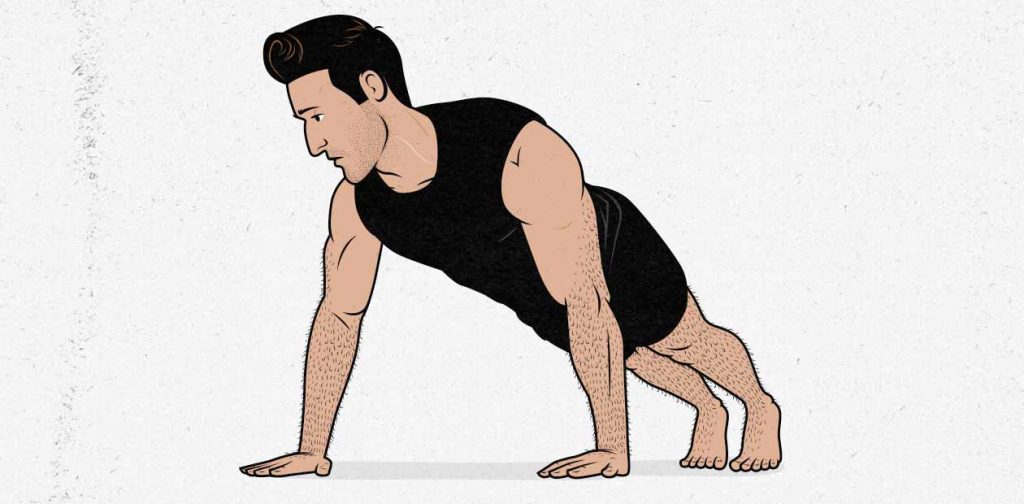
There are a few good reasons why beginners should be doing push-ups:
- Push-ups are much easier to learn.
- Push-ups can be made easier or harder based on your experience level and strength. If you can’t do a classic push-up, you can do them from your knees or with your hands raised on a bench.
- Push-ups work our shoulder joints through a larger range of motion, stimulating a greater number of overall muscle fibres.
- Push-ups are easier on our shoulder joints, especially for skinny guys, and especially for beginners who aren’t lifting with stellar technique yet.
- The bench press is excellent for bulking up our chests, shoulders, and triceps. The push-ups are just as good at that, but they also bulk up our abs and serratus muscles.
Until we do at least 20 push-ups with great technique, there’s little benefit to benching. Not only are push-ups simpler, easier, and safer than the bench press, but they’re also better for building muscle—if you’re a beginner.
Once you can do 20 push-ups, you’re going to start running into problems. If you keep increasing the repetitions, you’ll soon begin to challenge your cardiovascular fitness and pain tolerance more than you challenge your muscle strength. At that point, it’s time to approach the bench.

The bench press is a fantastic lift for intermediate lifters. Being able to add weight to the bar steadily means that you can stick to the rep range that’s best for building muscle (often 6–12 reps for the bench press).
Caveats: there are other ways to progress to the bench press. You don’t have to begin with push-ups. Another approach that we use is starting with the dumbbell bench press, which works especially well for guys with stubborn chests.
The Front Squat Versus the Goblet Squat
The front squat is another good example. The front squat is the best squat variation for building overall muscle mass, but it’s also a hard lift to learn. In fact, it’s often borderline impossible for a beginner to learn. You need decent posture, solid upper back strength, and flexible wrists and ankles.

There’s a simple solution to this problem, though. If you can’t do a front squat, start with goblet squats instead. Just like a front squat, goblet squats have all the same benefits as front squats:
- Front-loaded squats allow us to keep our torsos more upright, allowing us to squat deeper. That broader range of motion makes them better for bulking up our lower bodies.
- Holding the weight in front of our bodies challenges our upper back and core muscles, making them superior for gaining overall muscle size.
- They challenge the postural muscles all along our posterior chain, helping to improve our posture.
Front squats and goblet squats are similar in the most critical ways. The goblet squat is better for beginners, though, because it doesn’t require much skill or flexibility. It’s a brute strength lift. You pick up the weight in your hands, and you squat it. Beginners can skip the learning curve and build muscle from day one.
However, once you’re strong enough to do ten goblet squats with the heaviest dumbbells you have, you’ll start running into problems. That’s where the front squat comes in. It has the very same advantage as the bench press: it allows you to progressively add more weight to the barbell. That way you can keeping lifting within the narrow rep range that’s best for helping you build muscle (usually something like 4–7 reps for front squats).
Progressing to Your First Chin-Up
Chin-ups are another great lift that’s hard for beginners. Yes, chin-ups (with an underhand grip) are by far the best lift for building a big upper back and killer biceps. However, until you can do 5–10 chin-ups, you can’t reap those rewards.
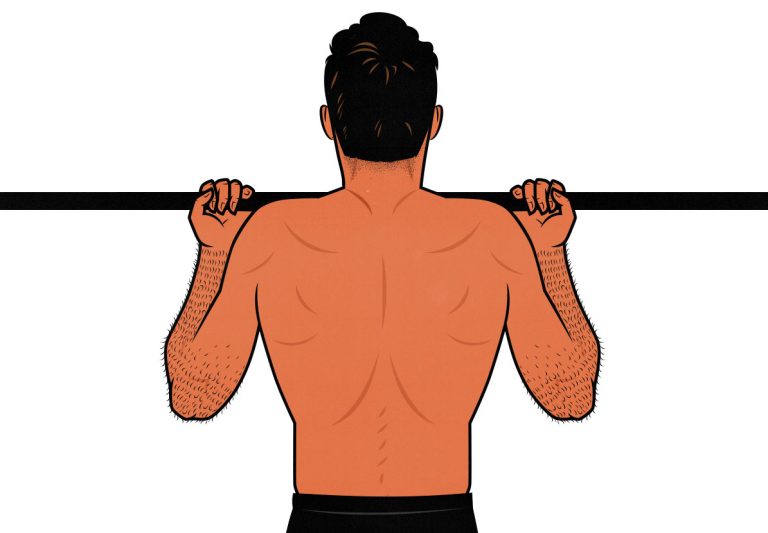
Furthermore, chin-ups are best when they’re done with a massive range of motion, starting from a dead hang and then bringing your chest up to the bar. That’s no easy feat!
What we want to do with beginners is set them on the proper path to badass chin-up strength, but it might take a few months of hard bulking before they’re able to do a proper set of chin-ups.
That means that a beginner is often best served by doing lowered chin-ups, curls, and rows until they’ve developed the strength to do classic chin-ups.
Now, when it comes to the difference between an intermediate and an advanced lifter, we’re talking about someone who’s having trouble making progress on these big compound lifts. If someone is having difficulty gaining strength on the bench press, front squat, chin-up, deadlift, and overhead press, then we might need to bring in some even more advanced variations.
Progressing the Deadlift
We skipped over the deadlift before, so let’s talk about it here. At an intermediate level, you’ll probably make progress by merely grinding away at your deadlifts. Maybe you add in some stock assistance lifts, such as Romanian deadlifts, and some stock accessory lifts, such as rows. That’s going to help you bulk up all of the relevant muscles, so as long as you’re eating a proper bulking diet and pushing yourself in the gym, your deadlift should progress reasonably smoothly.

However, at a certain point, you might notice that some muscles are holding you back. Some aspects of your technique are crumbling. Perhaps you see that your back is rounding when you try to lift heavier. That might be a hint that your back is tired because you’re overworking it. Or, more likely, you haven’t been working it enough.
These are the kinds of nuanced decisions that advanced lifters need to deal with. In this case, maybe you decide to switch to doing snatch-grip deadlifts, which require more hip mobility but do a better job of developing your upper back. Then, as an accessory lift, perhaps you add in some bent-over barbell rows to help bulk up your spinal erectors and lats.
Do the Lifts That Suit You Best
The newer you are to lifting, the simpler your lifts should be. Not only does it flatten the learning curve, but it also lets you push your muscles harder, helps you learn better technique, and keep your workouts safer.
- Beginner: If you’re new to lifting weights, use beginner exercise variations, such as goblet squats, push-ups, and Romanian deadlifts. You can also do simple isolation exercises like shoulder raises and neck curls.
- Intermediate: when you get too strong for the beginner exercises, advance to heavier variations, such as front squats, high-bar squats, bench presses, and weighted chin-ups.
- Advanced: eventually, heavier variations can become too heavy. When you’re deadlifting 500 pounds, it’s not just a workout anymore, it’s a full-fledged war. You might want to mix in variations that allow you to work your muscles just as hard without taxing your body quite so much. Maybe that means doing good mornings or reverse hyperextension.
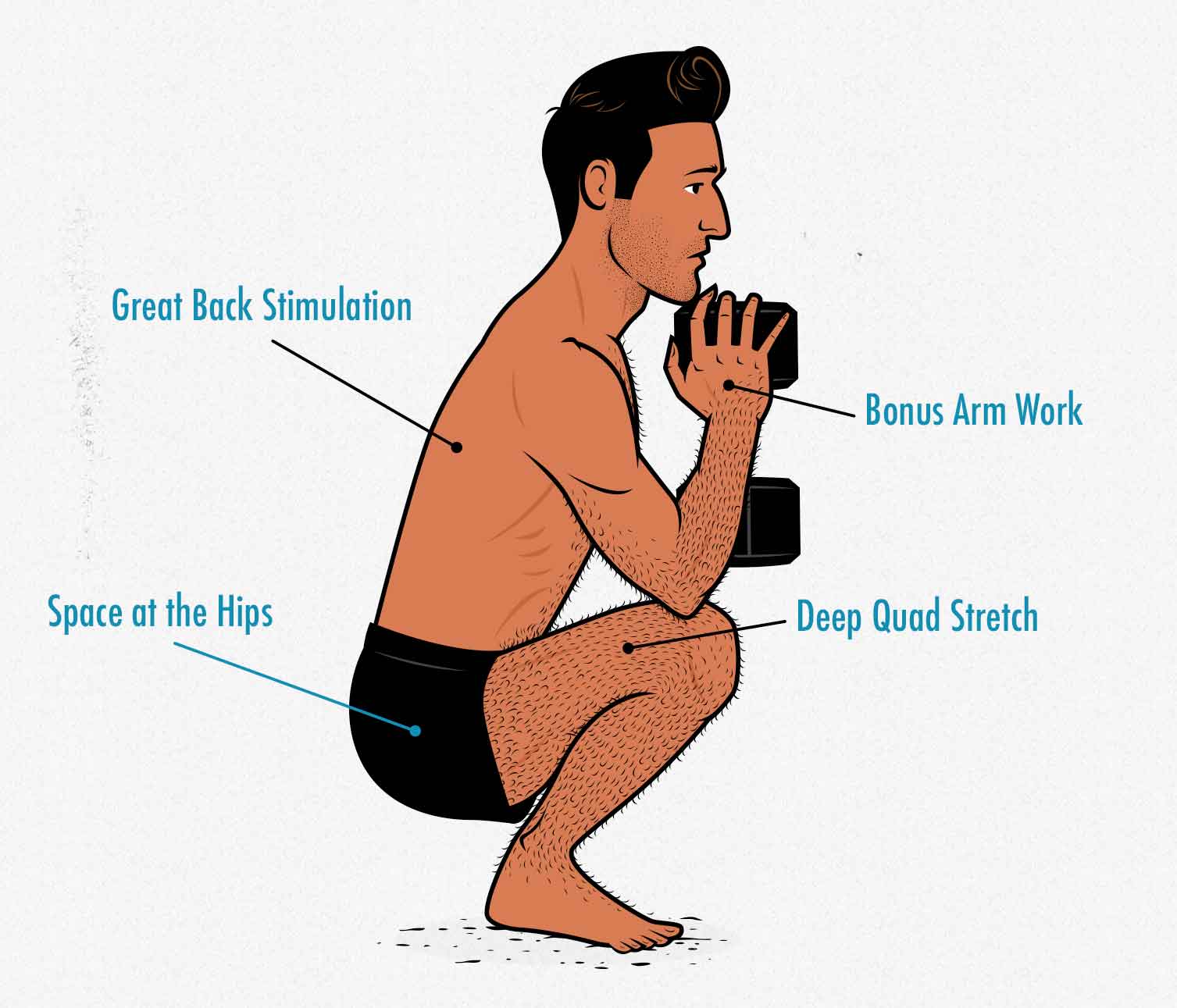
What we do in our Bony to Beastly Bulking Program is start beginners off with a Phase Zero, where we teach them the ropes. This phase is all about mastering push-ups, goblet squats, Romanian deadlifts, and building some basic upper-back and biceps strength to prepare for chin-ups. This phase isn’t easier. You still need to push yourself just as hard. You’ll still stimulate just as much muscle growth. The exercises are just simpler.
If someone has more lifting experience, we have them start right into Phase One. Here, we get into the bigger bulking lifts, loading them heavier, focusing more on progressive overload. When people encounter problems or plateaus, we coach them through it.
How Quickly Can You Gain Muscle?
The further you are from your muscular genetic potential, the more quickly you can build muscle. That means that you may benefit from bulking more aggressively, eating more calories, gaining more weight each week.
However, the rate you can gain muscle has less to do with how long you’ve been lifting, more with how muscular you are. For example, even if a skinny guy has been lifting for ten years, he still has plenty of room for growth on his frame, so he can probably handle a pretty aggressive bulking diet. For another example, if you’re skinny-fat, being far from your muscular genetic potential means you can probably build muscle while losing fat.
- Beginner bulker: someone who can still take advantage of their newbie gains by eating an aggressive bulking diet.
- Intermediate and advanced bulker: someone who will benefit from a slower and steadier approach to bulking.
The Link Between Muscle & Strength
Gaining strength and gaining muscle are similar. The more muscle we have on our frames, the higher our strength potential is. For example, how much someone can bench press directly correlates with how big their chests, shoulders, and triceps are. Muscle size and muscle strength are intimately linked together.
However, just because someone is bigger doesn’t necessarily mean they’ll be stronger at the big compound lifts. For example, if someone bulks up their legs with the leg press, they may never develop the back strength needed for heavy front squatting. This adds some distinction between the size and strength sections.
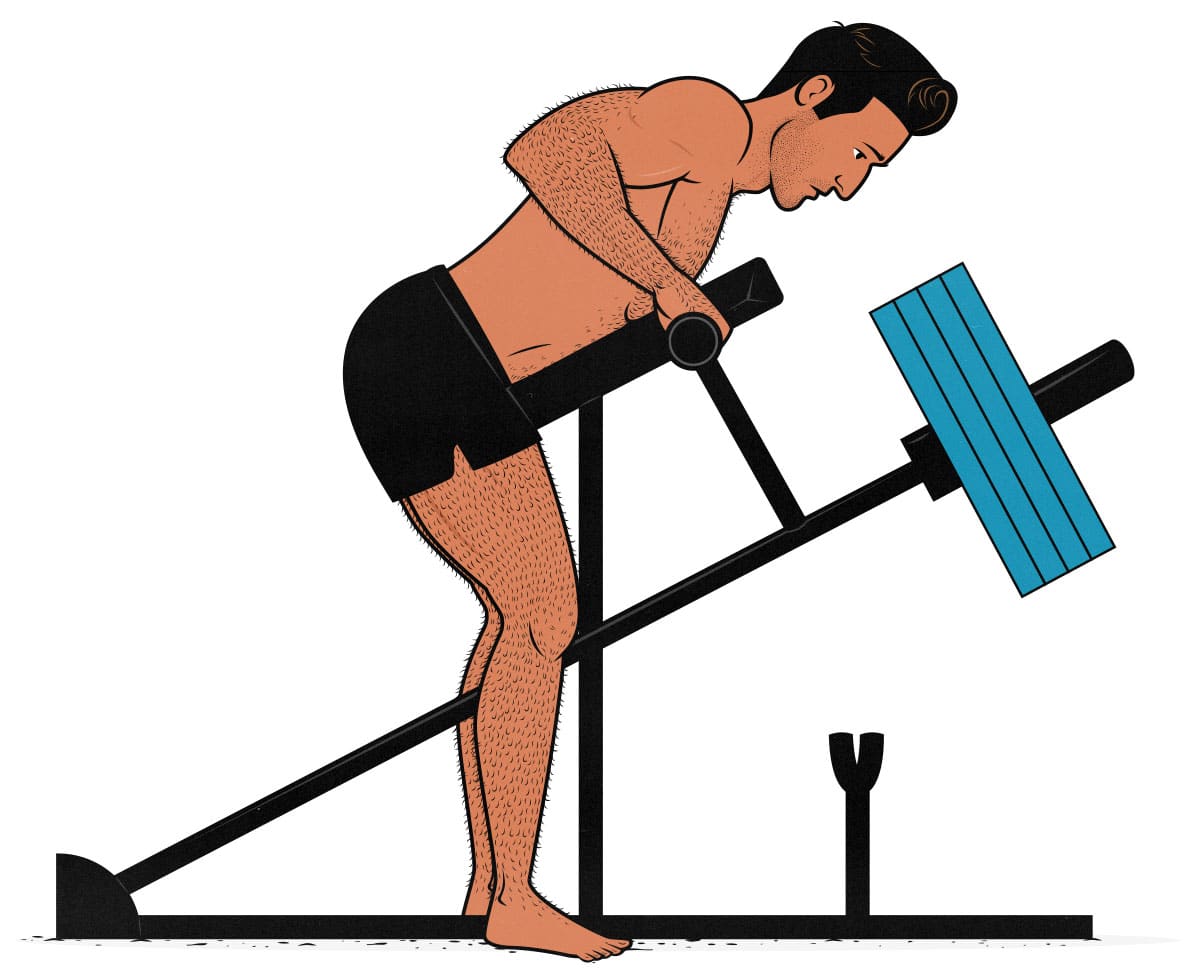
Beginners Can Gain Scary Amounts of Strength
If you’re newer to lifting weights, you can quickly improve your coordination and rapidly build muscle. This allows you to gain strength at breakneck speed. During this period, it can help to do each lift multiple times per week, allowing you to add small amounts of weight to the barbell more often.
Let’s say you do goblet squats once per week, aiming for eight repetitions each time, adding 5 pounds whenever you succeed. That’s progressive overload. That’s great. But since you’re only squatting once per week, you’re only adding 5 pounds per week.
Many beginners can gain strength faster than that. A beginner might be able to add five pounds on Monday, another five pounds on Wednesday, and then another five on Friday. That allows you to pile fifteen pounds on your squat every week.
Doing lifts more often also gives us more practice, allowing us to improve our technique more quickly. If you’re trying to learn how to do goblet squats, push-ups, chin-ups, and Romanian deadlifts, practice them more often.
You’ll eventually plateau. Strength gains aren’t linear. Your rate of muscle growth will slow. You’ll develop good technique. Soon it will take you several workouts before you can increase the weight. But you may as well ride the rapid strength gains while you can.
Intermediates Benefit From More Variety
At an intermediate level, smaller compound and isolation lifts are often introduced, and some people find that they aren’t able to train as hard as often. Once your strength starts to plateau with a beginner program, it often makes sense to switch to a plan with a greater variety of exercises, but to train those lifts with a slightly lower training frequency: 1–2 times per week instead of 2–3 times per week.
- Greater exercise variety means that you’ll stimulate a greater variety of muscle fibres, making them bigger and fuller (study).
- Different lifts have different strength curves and emphasize different muscle groups, yielding more balanced overall muscle growth.
- Varying your lifts reduces your chances of developing overuse injuries, such as developing cranky shoulders from incessant bench pressing.
At an intermediate level, training a muscle twice per week seems to be just as effective as training it three times per week. As a result, you might choose to train each movement pattern less often.
The Law of Diminishing Returns
So if we classify someone’s lifting level according to their rate of strength progress, we get something along these lines:
- Beginner lifter: someone who can add weight to the bar multiple times per week. For example, they add five pounds to their squat every Monday, Wednesday, and Friday.
- Intermediate lifter: someone who can add weight to the bar every week. For example, they add five pounds to their squat every Monday.
- Advanced lifter: someone who can only add weight to the bar every few weeks. At this level, training is typically organized into phases (or blocks). An advanced lifter would add weight to the bar at the end of every training phase.
Milk the beginner phase for as long as possible, gaining strength with fearsome speed. When that stops working, switch to intermediate workout programs, persisting with them for as long as you can. When that stops working, gear into advanced programming, fighting for gradual progress.
Beginner, Intermediate & Advanced Bulkers
Okay, so, let’s take a fresh look at these three physiques. The skinny guy on the left is probably a beginner, and the muscular guy on the right is likely a more advanced lifter, but it’s hard to say for sure.
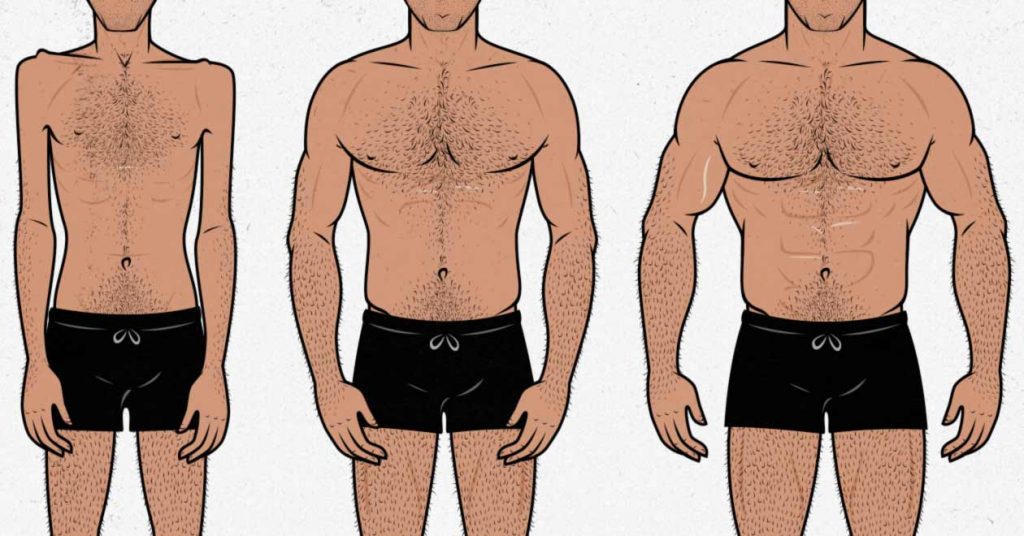
The skinny guy might have excellent lifting technique and mobility, allowing him to do deep front squats with ease. The muscular guy might have bulked up his lower body with the leg press, never developing the back strength or the shoulder mobility that he needs to even get into the starting position for the front squat.
By that same token, the muscular guy clearly has a muscular chest, big shoulders, and burly triceps. There’s no doubt that he’s going to be able to bench press a good amount of weight. In fact, he may already be getting quite close to his muscular genetic potential on the bench press.
Furthermore, given the sheer muscle mass in his shoulder girdle, his bench press is probably well over 300 pounds. That huge amount of weight that he’s pressing may warrant an intermediate program, using a greater variety of exercises in order to keep his shoulder joints healthy.
Someone’s lifting level doesn’t always correlate with how long they’ve been lifting or how muscular or strong they are. Furthermore, some guys are beginners in some ways, advanced in others. Still, we can make some good generalizations. Then, if you understand the underlying principles, you can modify them accordingly.
Beginner Bulkers

Beginner Bulking Lifts
The best lifts for beginners are the brute strength exercises that are easy to learn. Think of lifts like push-ups, goblet squats, Romanian deadlifts, dumbbells rows, biceps curls, and lateral raises. These lifts are simple, which will help you bulk up in a hurry while improving your lifting technique and overall coordination.
You can stick with these lifts until they become hard to progress with. There’s only so heavy you can make a push-up or goblet squat. Or you could blast past these lifts quickly, progressing to heavier variations as soon as you feel ready for them.
Beginner Bulking Programs
The best workout programs for beginners tend to be somewhat repetitive. They probably involve doing the same lifts several times per week, often in the same repetition range. Since you’re learning new skills and developing new habits, though, this repetition is a good thing.
For example, you might be doing 8-rep goblet squats 2–3 times per week. That’s going to give you plenty of practice with the lift, and you’ll have a chance to outlift yourself a couple of times each week. That’s going to allow for incredibly quick progress.
How Quickly Should a Skinny Beginner Bulk?
Due to a phenomenon called newbie gains, beginners often benefit from pretty aggressive bulking. We often recommend that beginners eat a hearty bulking diet, with a calorie surplus of around 500 calories, aiming to around a pound per week.
This aspect of bulking is easier said than done. For us naturally skinny guys, eating enough calories to bulk up can be incredibly difficult. This is how ectomorphs often get stuck at a beginner level, sometimes for years. It’s how I got stuck, anyway.
The beginner phase is a flash of beauty. Enjoy it for as long as you possibly can. I gained forty pounds this way, but I was exceptionally skinny. You’ll probably gain less.
Intermediate Bulkers

Intermediate Bulking Lifts
This trick with bulking up as an intermediate lifter is to get stronger at the big compound lifts. This is where the Big 5 compound lifts come in:
But intermediate lifters also benefit from greater exercise variety, so feel free to include a good bunch of assistance and accessory lifts. That will help you build stronger, rounder, fuller, and more aesthetic muscles while keeping your joints healthy and strong.
Intermediate Bulking Programs
The intermediate phase is long, and you’ll gain more strength, skill, and knowledge as you progress. Experiment with various programming styles to see what you and your muscles prefer.
How Quickly Should an Intermediate Bulk?
Intermediates aren’t able to gain size and strength as quickly as beginners, so they’ll often benefit from a less aggressive bulking diet. Aiming to gain 0.25–0.75 pounds per week usually works well.
I gained a pound per week all through my intermediate phase, taking little breaks here and there to trim off any excess fat. There’s no right or wrong way to do it.
The intermediate phase is where you’ll live. You won’t be growing as quickly, no, but you’ll get to experience the joy of living in a fitter, stronger, healthier, and more attractive body. The progress will come slowly, but it will come.
I’ve gained another 25 pounds since leaving the beginner stage. I’m 65 pounds heavier than when I started. Progress is harder to come by, but to be honest, I don’t care. I just feel grateful to be in this body.
Advanced Bulkers
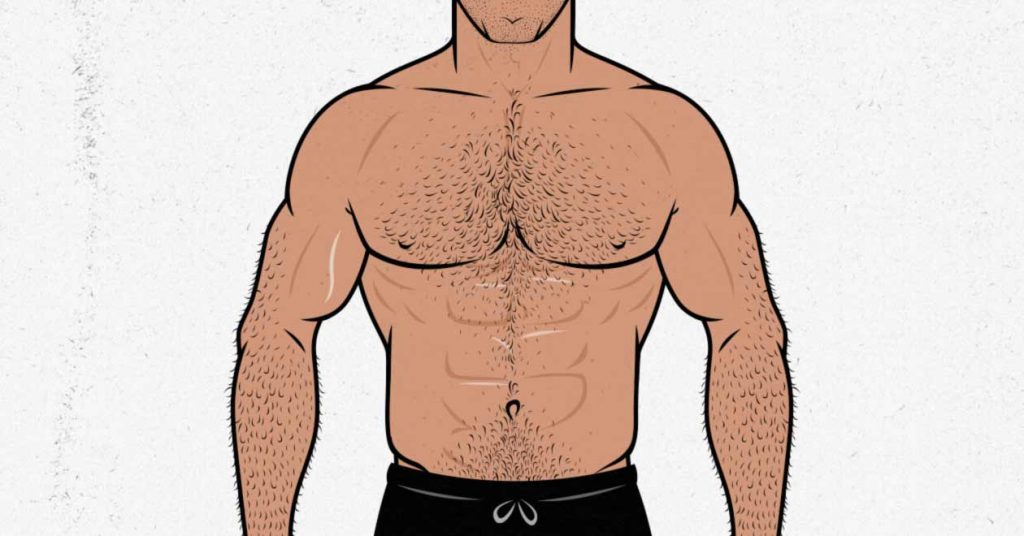
Advanced Bulking Lifts
Advanced lifters should still focus on the Big 5 bulking lifts, but more furtively. They might spend months training different variations. They should choose specific variations tailored to their own specific strengths and weaknesses.
Advanced Bulking Programs
Over the course of their long intermediate phase, an advanced lifter will likely have learned what style of programming their body responds best to. There’s no single best program or training approach for an advanced lifter.
How Quickly Should an Advanced Lifter Bulk?
How advanced we are can determine how quickly we should gain weight while bulking. Some experts, such as Eric Helms, PhD, recommend that advanced lifters gain a fraction of a pound every couple of weeks. The idea is that progress is slow, so a slower rate of weight gain will lead to leaner muscle growth.
Other experts, such as Mike Israetel, PhD, recommend that advanced lifters start bulking more aggressively again, gaining up to a pound per week. The idea is that progress is hard, so a faster rate of weight gain will give an advanced lifter a better chance of gaining muscle size and strength.
Takeaway
There are a few different ways to sort people into beginner, intermediate, and advanced lifters. The most popular way of sorting people is based on their general strength, such as how much they can squat, bench press, and deadlift. This can be useful sometimes. Weaker lifters often do best with 3 full-body workouts per week, whereas stronger lifters might benefit from spreading their exercises over more workout days.
You should also consider how well you can perform the exercises. Can you squat deeply, bring the barbell to your chest when bench pressing, deadlift with a strong posture, and do push-ups from a perfect plank position? If you’re still learning, choose a program to help you learn.
When deciding how quickly to bulk, consider how far away from your genetic potential you are. For example, if you’re still skinny, you can expect to build muscle faster, so you can afford to bulk more aggressively.

Alright, that’s it for now. If you want more muscle-building information, we have a free bulking newsletter for skinny guys. If you want a full foundational bulking program, including a 5-month full-body workout routine, diet guide, recipe book, and online coaching, check out our Bony to Beastly Bulking Program. Or, if you want a customizable intermediate bulking program, check out our Outlift Program.

